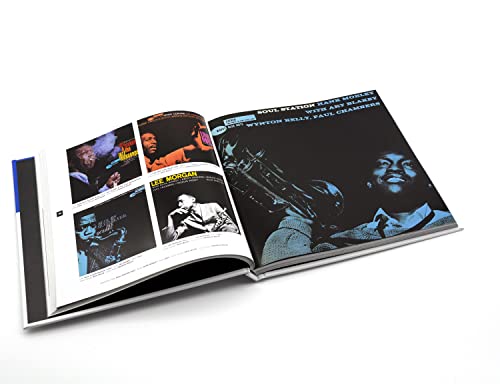The Cover Art of Blue Note Records: The Collection
£15.40£20.90 (-26%)
The Cover Art of Blue Note Records is Graham Marsh and Glyn Callingham’s classic collection of the unparalleled record sleeves produced by the celebrated Blue Note record label.
Around January 1956 the photographer Francis Wolff and Alfred Lion of Blue Note Records met Reid Miles, a commercial artists and a devout classical music fan. After establishing a rapport, Reid Miles became the designer for the Blue Note label for the next eleven years creating wonderful graphic covers that were both unique and also retaining the indefinable Blue Note look. Featuring iconic covers for artists such as Herbie Hancock, Thelonious Monk, Miles Davis, John Coltrane, Sonny Rollins and Art Blakey, this anthology is an evocative piece of Jazz history.
Alongside over 400 of the record label’s best album covers is a selection of short essays written by leading industry figures. Both a comprehensive guide to an acclaimed label, and an insightful snapshot of graphic design history, The Cover Art of Blue Note Records is a must-have for all Jazz fans.
Read more
Additional information
| Publisher | Collins & Brown, 1st edition (15 April 2021) |
|---|---|
| Language | English |
| Hardcover | 240 pages |
| ISBN-10 | 1911163701 |
| ISBN-13 | 978-1911163701 |
| Dimensions | 22.6 x 2.2 x 22.6 cm |












by John E Fitzgerald
The book features some terrific photos of Blue Note artists and album covers. It’s a superb keepsake for the jazz afficiando and as a design reference book.
by Jon Dingwall
A must have for avid jazz fans with glorious reproduction covers of some of the greatest albums of all time.
Perhaps the most iconic cover ever is represented here by John Coltranes ‘Blue Train’
in actual size it is perfect for mounting and framing if you can procure two copies.
Other great covers such as Wayne Shorter’s ‘Speak no Evil’ and McCoy Tyner’s ‘The Real McCoy’ are scaled down to the extent that they cannot be framed which sadly is a missed opportunity
by Amazon Customer
Fabulous book!
Chocabloc full of photos of album covers, great art references both visually and musically.
Wonderful, packed full of high quality images and lots of information.
A great keepsake and a great present for lovers of album covers, music history and jazz.
by Ian WD3
This is an outstanding book, but if you want in-depth analysis of the individual recordings, you might be a trifle disappointed. I wasn’t disappointed at all.
For me, Blue Note was and is about the “whole” – the music and the photography used on the album covers. There was a style that was unmatched or rivalled. Columbia tried hard (‘Kind of Blue’ by Miles Davis came very close) but Blue Note were pretty much the leaders.
I love this book. Even better who listening to the music with an ale or coffee in hand!
by Craig
Purchasing the original two volume edition these days means taking out a second mortgage, so praise be for this 2021 hardback collection! If you’re reading this review then you already know that designer Reid Miles and photographer Francis Wolff produced probably the best album cover art for any record label across any musical genre ever. This is ART irrespective of it’s commercial origins to advertise LP records in the 1950s and 60s and it’s only the notorious snobbery of the art world which has prevented wider public recognition.
For me, Miles/Wolff completely defined the inspirational look of Blue Note records, (I bet you too can immediately identify a Blue Note album in an LP record rack just by the combination of cropped photo and typography, right?), so it’s something of a shock looking at some of the album covers from the late 1960s after Reid Miles left the label because the sleeves are so…. ordinary, unexceptional, even boring to look at.
Nevermind, fortunately Marsh and Callingham have only included a few of these.
I would have given this a five star review mainly because it should have been printed as a larger sized volume to do full justice to the exceptional art within but also for the repetition quotes from the same individuals used within and for the glaring error in the author’s introduction which states that Blue Note was founded in 1959!
by W. Bolden
If you don’t have (or can’t afford) the original two full size issues of the Blue Note Cover Art books, then this single edition is just as good (although on a slightly smaller scale, dimensionally). Pure nostalgia looking at the cover photos – its amazing how just looking at a picture of, say Grant Green’s “Green Street”, can bring back the feeling of the 60’s era that was my youth. Useful inclusion of some Japanese issue Blue Notes that I did not even know the existence of (and some fine original black & white photos) – a must for any Blue Note collector!
by Colin
The Cover Art of Blue Note Records is Graham Marsh and Glyn Callingham’s classic collection of the finest record sleeves produced by the celebrated Blue Note record label. This hard cover edition is the complete compilation of the original volumes published nearly two decades ago. Including every cover, essay and photo that appeared in the original volumes, this collection is bound to appeal. Iconic covers of artists such as Herbie Hancock, Wayne Shorter, Thelonious Monk, Miles Davis, John Coltrane, Sonny Rollins, Eric Dolphy, Dexter Gordon, Lee Morgan, Grant Green, Stanley Turrentine, Lou Donaldson, Cannonball Adderley, Donald Byrd, Ornette Coleman, Jimmy Smith, Jackie McLean, Kenny Burrell and Art Blakey, make this anthology an evocative piece of Jazz history. With over 400 of the best covers in the record label’s history and a selection of short essays, this is a comprehensive guide for all Jazz fans and anyone interested in classic design.
A splendid timeless collector’s piece for all music fans.
by deejayem
Somewhat disconcerting that three paragraphs in to the book’s “Foreword” section and the authors Blue Note knowledge is questionable. For example, Marsh & Callingham inform us that the record label was founded in 1959 when in actual fact it was founded in 1939. In the same paragraph they state that the label reached its ‘legendary status in the mid-50’s’.
In addition, a lot of the images and artwork are very poorly reproduced.
I think the authors are cashing in on the coffee table trend but fall well short of the mark.
Overall a disappointing purchase and will look elsewhere for a better book about the Blue Note label.